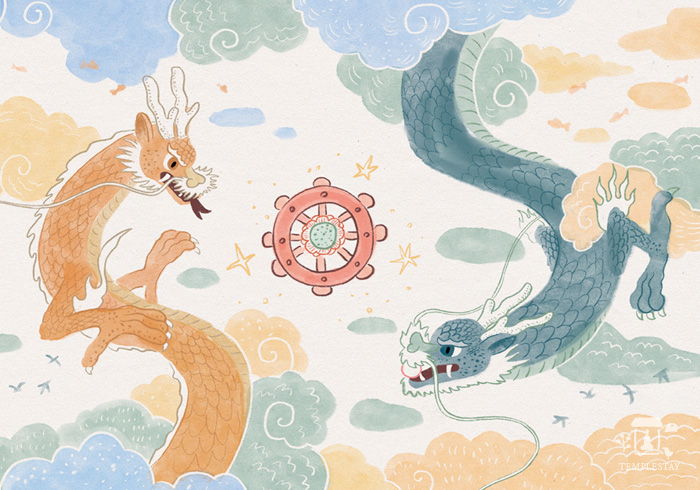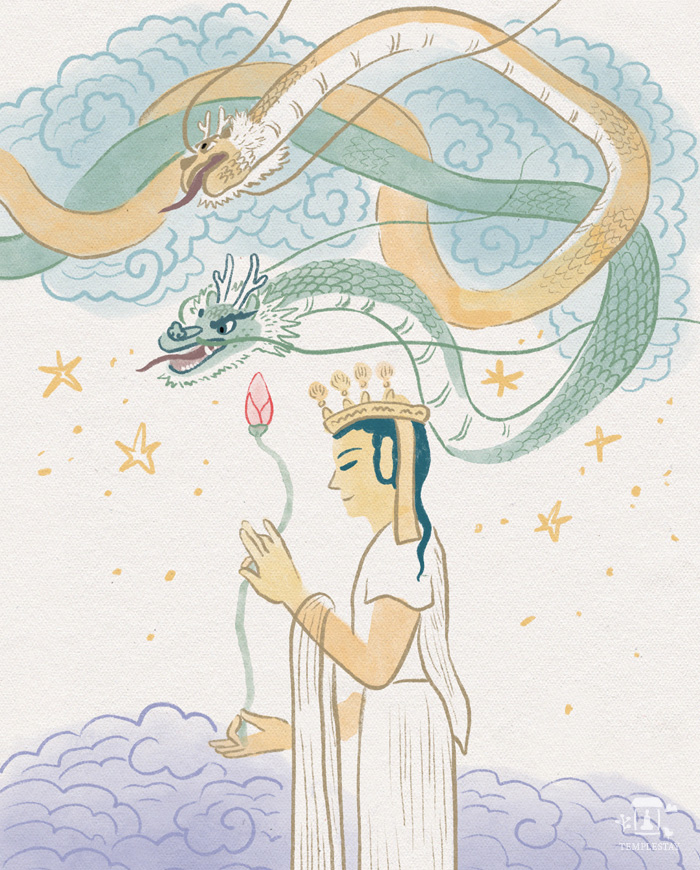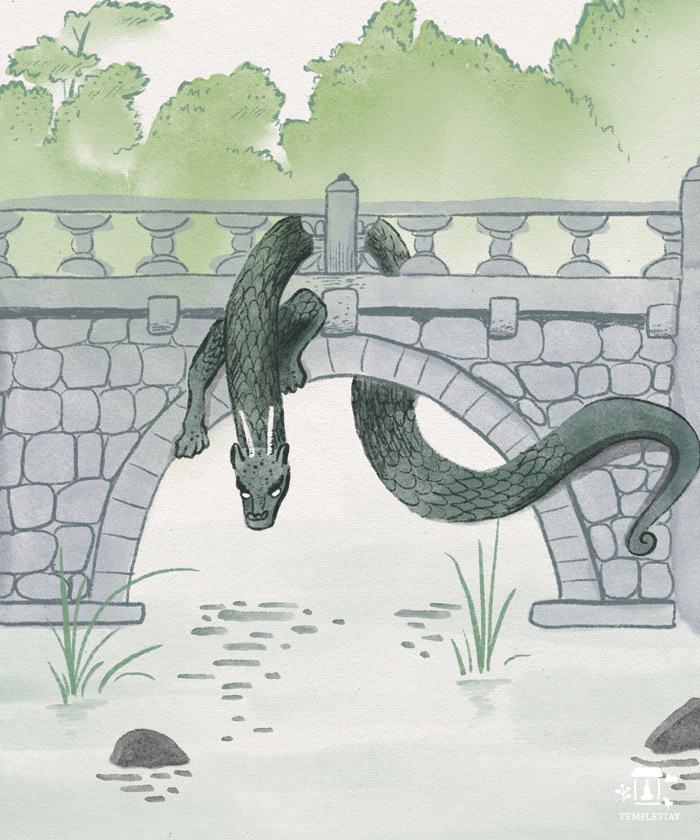A Very Old Community
Text by. Lim Taek-su Illustration by. Kim Sang-gyu

There is a saying that you should not go into the water after Cheoseo, the traditional end to summer’s heat, which is based on the Chinese 24 solar terms. However, this year, even after Cheoeo, the heat did not subside, and tropical nights continued to be felt in the city and along the coast. The heat wave was like a “wet sauna,” and I had to shower and change clothes four times a day while working as a guide to Templestay participants. Summer is finally coming to an end, and the forest rejoices in the autumn sunlight. Not only Korean nutmeg, cork oak, and white oak trees, but also more than ten types of maple trees, including three-flowered maples, Korean maples and ashleaf maples, are producing red and yellow pigments to create a sea of red leaves all over the mountains. Soon, the trees will begin regulating the flow of water in their bodies to prevent cells from freezing. This is how they endure the cold.
When taking Templestay participants on a tour around the temple, I sometimes get unexpected questions from them. For example, one question was about the tall bodhi tree next to the Bell Pavilion. The bodhi tree at Baekyangsa Temple is not the Indian bodhi tree in the Moraceae family (Kr. Borisu) that is sacred in Buddhism. It is a Tilia miqueliana in the Pinaceae family (Kr. Borija). Since legend says Shakyamuni Buddha attained enlightenment while sitting in the shade of the bodhi tree, I’m sure the Korean Buddhists also wanted a bodhi tree in Korea as well. However, since the Indian bodhi tree does not grow naturally in Korea, finding a relative was the logical alternative. It was a kind of cultural borrowing, and the temple now considers this tree its bodhi tree.
The most recent question I received from a participant was about dragons. At the end of the temple tour that day, one participant pointed toward the roof of Daeungjeon (Great Hero Hall), pointing to the dragon’s head tiles decorating both ends of the ridge. In a typical hanok (traditional Korean house), this would be where the mangwa or the place where the concave roof-end tiles would be placed. When I zoomed in on the pictures taken with my phone, I saw that the dragon’s head was holding a wish-fulfilling gem in its mouth and was slightly raising its head. I saw traces of white clay used to attach the dragon’s head, but since I didn’t see this in old photos of Daeungjeon, I assumed this was a more recent change. Later, when I asked a senior monk, he said that the dragon’s heads were placed there when Daeungjeon was rebuilt in the mid-1990s. I then walked around Daeungjeon Hall. Each of the wooden brackets at the four corners of the exterior was decorated with a dragon’s head holding a wish-fulfilling gem.
They appeared vivid and dynamic, but I also found them a bit humorous and couldn’t help but smile. I took a few steps back and looked closely at the roof of Daeungjeon. In the center of the ridge, a blue tile protruded. I had once read that one or two blue tiles were given as gifts to a temple from the royal family. Since a key ingredient in these blue tiles was saltpeter, a mineral regulated by the state, these tiles were used only in palaces and buildings related to the royal family. And because they were a symbol of royal authority and luxury, temples with blue tiles were protected as royal temples, and it is presumed that exhibiting these blue tiles was intended to show they were royal temples. It must have been a desperate attempt to protect temples and monks from government offices and aristocrats due to the Joseon Dynasty’s anti-Buddhist policy.

The interior of Daeungjeon Hall reveals a community of auspicious beings, the most striking one being the dragon. On the main beam of Daeungjeon’s ceiling, four dragons perch on the chungnyang (a horizontal beam connecting the pillar of a side wall to the main cross beam). They face each other with their long bellies exposed. They are guarding the Buddha and Buddha dharma with glaring eyes wide open and holding a wish-fulfilling gem in their mouths. On the canopy above the altar, a yellow dragon and a blue dragon also hold a wish-fulfilling gem in their claws, their mouths open and tongues flicking out. On the cross beams on both sides near the center, a blue dragon is painted flying above the clouds, ready to summon a thunderstorm at any moment.
The dragon is the temple’s guardian deity. It has immeasurable power, guards the Buddha dharma and the temple, and possesses the power to manifest in countless shapes and forms. During Korea’s Three Kingdoms period, Buddhism was accepted and promoted by the royal families of both Goguryeo and Baekje, and was able to develop with the help of their protection. They saw Buddhism as a means to preserve the state and advance the prosperity of the royal family. On the other hand, Silla’s royal family opposed it fiercely. However, ultimately, the martyrdom of Yi Cha-don became the key event through which Silla royalty officially recognized Buddhism, an event that laid the foundation for Buddhism to take root. The Silla dragon that appears in the Samguk yusa (Legends and History of Korea’s Three Kingdoms) is described as the protector of the Buddha dharma and one who helps to edify sentient beings. After the unification of the Three Kingdoms, Buddhism in Korea took on an additional role of “state protector,” and the dragon became the symbol of its power to protect.
Hwangnyongsa (one of Silla’s major temples), Tongdosa in Yangsan (built on the site of a pond where nine poisonous dragons lived), and Mireuksa Temple Site (associated with the legend of King Mu of Baekje and Princess Seonhwa). These are all temples and sites of temples where ponds inhabited by dragons were originally located. As temples were built on these sites, the dragons that lived there either moved to other places or became guardian deities who protected the temples. From King Munmu’ s words that he would become a dragon to protect the country after his death, and tales related to Manpasikjeok (The Magic Flute with Incredible Power), we can see that dragons are closely tied to the idea of protecting the country.
As the dragon was likened to an excellent being or a great man, royal authority and the throne were symbolized by the dragon. Therefore, the prefix "yong (dragon)” was almost always added to refer to anything related to the king. The king’s face was called “yong-an (dragon face),” his throne was called “yong-sang (dragon seat),” and his tears were called “yong-ru (dragon tears).” The king’s ascension to the throne was expressed as “yong-bi (soaring dragon).” In the imperial or royal family, the number of claws a dragon image had also indicated the rank of the king, with five-claws usually representing an emperor.
Among the people, dragons were considered to be gods of rain that could bring or halt rain at will. There were also dragon king gods who provided safe navigation and abundant fishing for fishermen. Long ago, the dragon king was the main entity who protected the sutras in the dragon palace. It is said that Nagarjuna, who wrote the Buddhist treatise Mūlamadhyamaka-kārikā (Fundamental Verses of the Middle Way), entered this dragon palace and brought out Mahayana Buddhism’s Avatamsaka Sutra. The authority of the sutras was relegated to the dragon king who lived in the sea. In the “Water and Earth” section of Guanzi, it is said that dragons are the gods of the five colors born from water. They ascend to the sky at the spring equinox and submerge themselves in a pond at the autumn equinox. As the king of the sea, the dragon king rules over the water realm and controls rain and wind. However, without a wish-fulfilling gem, the dragon cannot exert its power.
As dragons are imaginary creatures, they have an unearthly appearance because, it is said, they were created by combining the attributes of various animals. The appearance of the dragon described in the Chinese encyclopedia Guangya, written by Zhang Yi of the Wei Dynasty, is as follows: “Its head resembles a camel’s, its horns resemble deer antlers, its eyes resemble a rabbit’s, its ears resemble a cow’s, its nape resembles a snake’s, its belly resembles a large clam, its scales resemble a carp’s, its claws resemble an eagle’s, and its paws resemble a tiger’s.” It also has 81 scales (a positive number), and its scales make a sound like the ringing of a copper tray. It has two long whiskers beside its mouth, and on its neck, it has scales that are upside down. It is said that anyone who touches them will surely die.

According to Zhenzhuchuan, written by the Ming Dynasty’s Hu Chengzhi, there was a dragon who had nine sons. Each of them liked something different, and they manifested in various forms among the people. But why “nine?” In Chinese, the number “9” has the same pronunciation as “jiu (久),” which means “long-lasting, long-lived,” and was a number mainly used in the Chinese imperial court. Lee Ik (pen name Seongho; 1681―1763) wrote about this dragon’s nine sons in Seongho saseol (Miscellaneous Discussions of Seongho). Let’s take a look at the dragon’s nine children.
The first son is Bihui (or Paeha). His shape is similar to a turtle’s, and he likes to lift or carry heavy things on his back. The turtle-shaped stone pedestal that often supports a stele symbolizes Bihui. His body is like a turtle, but his head resembles the head of a dragon.
The second son is Imun, also called Jopung. He likes to sit in high places and look far away, so images of him are placed on the roof. He is also called Chimi, and he has the power to suppress fire when he appears. The Chimi (roof end tiles) at Hwangnyongsa Temple in Gyeongju is one example.
The third son is Poroe, and he actually resembles a dragon. He is weak-hearted, afraid of whales, and cries when he sees one, his cries sounding just like a bell. He is symbolized by the yongnyu, the dragonshaped hook on top of a temple bell.
The fourth son is Pye-an, “pye” meaning prison and “an” meaning a wild dog. His appearance resembles a tiger, and his image is often seen at the entrance of a government office or prison as a symbol of authority.
The fifth son is Docheol. He is very greedy and likes to eat and drink to excess. His image is often engraved on the handles of cauldrons and ceremonial vessels, and also on cauldrons and bowls as a warning against gluttony.
The sixth son is Gongbok. He likes water, so he is sometimes carved with only his head showing on the pillars of a bridge or under the arches of a stone bridge. Sometimes, he is depicted in the shape of an animal and placed at the water’s edge.
The seventh son is Aeja. Both “ae” and “ja” characters mean “outer corners of the eye,” suggesting a glaring look. He likes the smell of blood, so he is carved on the back or handle of a sword. The dragon on Guan Yu’s Green Dragon Crescent Blade is this son.
The eighth son is Sanye, also called Geumye. His shape is similar to a lion’s, and he likes fire and smoke. He is often carved on the legs or lids of incense burners, and his image is also used to decorate braziers. He is also the lion on which Manjushri Bodhisattva rides. The lion on the Buddha’s throne is also Sanye.
The ninth son is Chodo. His appearance is strange, resembling the combination of a frog and a conch. He likes to close doors and hide and is usually engraved on doorknobs or locks.
The dragon’s head on the ridge of Daeungjeon Hall at Baekyangsa Temple symbolizes the second son, Imun. As architecture developed and various symbols appeared, the son of the divine dragon was used as one of the devices to protect the building and express its characteristics. It is natural that the dignity of a building is increased by its ornamentation.
The yongnyu on Baekyangsa Temple’s bell is Poroe, the third son of the dragon. Iron wire is inserted through the body of the bent dragon to hang the bell. Poroe is particularly afraid of whales, so when the bell is struck with a whale-shaped wooden mallet, Poroe cries in shock, and the sound is louder and more powerful than thunder. Because Poroe had a good voice, his image was symbolically cast on temple bells to give it a sound that could awaken the world.
Those who visit Baekyangsa Temple must pass through Ssanggyeru Pavilion and cross Geungnakgyo Bridge to enter the temple compound. In Buddhist cosmology, for one to go to Mt. Sumeru from Jambudvīpa (the locus of human existence), one must cross seven mountains and the sea between the mountain ranges. There are eight bridges in total. People must let go of all secular desires and travel to the enlightened and tranquil buddha realm to see the buddhas, even if only for a moment.
On this past Buddha’s Birthday, I was captivated by the lanterns reflected on the surface of the pond at Ssanggyeru Pavilion and went down to the stream under Geungnakgyo Bridge. I noticed a stone sculpture sticking out from the center of the arched ceiling of the bridge, but I didn’t know who or what it was. Now I know. It was Gongbok, the sixth dragon son, standing guard under the bridge to prevent evil spirits and/or any natural disaster that might approach the temple via the stream.
Some say that dragons are everywhere in the temple. They wriggle along the roofs of the dharma halls, the eaves, the canopies, the main crossbeams, the top of the temple bell, and even on the donation boxes. Where are Sanye and Docheol? I think the remaining sons of the dragon that I have yet to find are still lurking somewhere in the temple.
Kim Sang-gyu studied visual design at Seoul National University. He is interested in nature, the environment, folk tales, legends, and religion. Starting with his first picture book, Dari's Soul Bead in 2022, he continues to work on picture books. Goryeo Buddhist Paintings, Pictures of Light and Wind, published in 2023, was selected as “an excellent work” in the Sejong Book Liberal Arts category.
Lim Taek-su serves as the Templestay team leader at Baekyangsa Temple in Jangseong. In 2024, he won the Dong-A Ilbo Spring Literary Contest with the short story Long Day, Long Night, and made his literary debut by simultaneously winning the 20th World Literature Award with the full-length novel Kim Seom and Park Hye-ram. He starts every day with a dawn Buddhist ceremony and prayer, and he lives his life forming new relationships every moment at temples.




